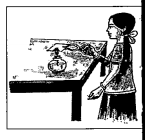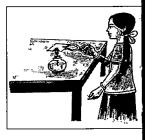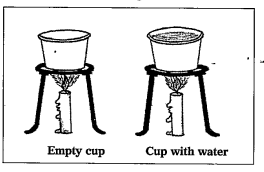Complete Solutions to EXAMPLE of chapter COMBUSTION, FUELS AND FLAME of Class 7 book with complete answers and questions
| Class 7 | CHEMISTRY |
| Chapter | COMBUSTION, FUELS AND FLAME |
| NCERT TELUGU | EXAMPLE |
| Number Of Questions | 100 |
| Academic Year | 2023-24 |
Give four examples of combustible materials
View SolutionGive four examples of non-combustible materials.
View SolutionWhy should not we store spirit or petrol near our living place?
View SolutionGive an example of a good fuel. How do you choose that fuel? Explain.
View SolutionThe oil fires should not be sprayed with water. Why?
View SolutionWhat precautions are to be taken while pouring water on fire?
View SolutionWhy a wick is not used in gas burners?
View SolutionWater is not used to control fires involving electrical equipment.Why?
View SolutionIt is difficult to burn a heap of green leaves but not a heap of dry leaves.Explain Why?
View SolutionWhat is combustion ?
View SolutionDefine fuel.
View SolutionWhat are non-combustible materials?
View SolutionWhat is ignition temperature?
View SolutionWhat is slow combustion? Give an example.
View SolutionHow many types of fuels are there? Give examples.
View SolutionExplain the zones of a candle flame.
View SolutionGive supporting arguments for both the statements (1) fire is useful (2) fire is harmful.
View SolutionIn a few years the fuels on earth will be exhausted. Think, what would happen to human civilzation?
View SolutionWhat would happen if oxygen stops to support combustion? Make a guess. And if it is the situation for what other works fuels are useful.
View SolutionUse of more fuels in our daily life causes air pollution and it is harmful to human being and the other life on earth. Suggest some remedies to avoid this.
View SolutionLet us assume that you are on the moon. If you try to focus sunlight on a paper using magnifying glass, does the paper catch fire? Or not Why?
View SolutionWhy do we keep phosphorus in water?
View SolutionWhy gaseous fuels are preferred over solid and liquid fuels?
View SolutionWhich zone is called the zone of complete combustion?
View SolutionWhy is it dangerous to burn coal in a closed room?
View SolutionWhy is water poured on burning wood to extinguish burning wood?
View SolutionWhy do some materials burn and some do not?
View SolutionA wax candle burns with a yellow flame. The domestic gas burns when lighted with a blue flame. Why?
View SolutionName the products formed when a candle burns in the air.
View SolutionCan you heat water in a paper vessel? How is it possible?
View Solution"Is combustion possible without the supply of oxygen? Discuss with your teacher/
View SolutionExplain giving reasons: In which of the following situations water will get hearted in shorter time?
Srikar kept water beaker near the wick in the yellow part of a candle flame.
View SolutionExplain giving reasons: In which of the following situations water will get hearted in shorter time?
Sonu kept water beaker in the outermost part of the flame.
View SolutionWhen do we say the combustion is incomplete combustion?
View SolutionHow can you control fire?
View SolutionHow does C`O_2` help in fire fighting?
View SolutionIn an experiment 10kg of a fuel produced 20000 kJ of heat. Calculate the calorifia value of the fuel.
View SolutionLPG stove at home is giving an yellow flame. What can this mean?
View SolutionExplain ignition temperature with an experiment.
View SolutionProject work: Collect information about the experiments of Joseph Priestly. Write a two page report describing Priestly’s experiments proving that oxygen is needed for burning. ` (AS_(3))`
View SolutionList the ways adopted by fire fighters to combat fires.
View SolutionCollect information available on different fuels. Find out the post per Kg and compare the cost with calorific value. Prepare report on that.
View SolutionCollect the information about annual fuel consumption in different parts of the world. How many remaining years the fossil fuels last? Make a poster with this information and issue an appeal to save fuel. `(AS_(4))`
View SolutionWhat are the drawbacks of solid fuels?
View SolutionCalorific value of wood is aproximately 17000-22000 kj/kg. What does it mean?
View SolutionWrite any six characteristics of a good fuel.
View SolutionWhat are the harmful effects of burning fossil fuels? How it effect the environment?
View SolutionWrite three things necessary to produce fire.
View SolutionDraw the diagram of candle flame and label all the zones.
View SolutionMadhu wants to avoid automobiles and started going to school by bicycle. Do you appreciate his decision?
View SolutionWhat steps you have to take to prevents fire at home?
View SolutionWhere do you find spontaneous combustion and rapid combustion in your daily life?
View SolutionHow do you organize your daily works with fuels to conserve bio-diversity?
View SolutionHow do you feel about "Fuels have become a part of human life"?
View SolutionDo all materials burn?
View SolutionWhat do you observe in your attempt of burning water?
View SolutionWhat happened to the lighted stick when it is brought closer to water in the plate?

View SolutionWhich of the material in the below activity is burning

View SolutionWrite an activity to prove that oxygen helps in burning.
View SolutionUnderstanding ignition temperature.
Take two small paper cups. Pour cups.Pour water in one of the cups put the two cups on different tripod stands and heat both of them using a candle.
Which cup burn first?
View SolutionUnderstanding ignition temperature.
Take two small paper cups. Pour cups.Pour water in one of the cups put the two cups on different tripod stands and heat both of them using a candle.
Which cup burn first?
View SolutionObserving the behaviour of different solid fuels.
Collect some fuels like candle coal, charcoal, magnesium ribbon, wood, cakes of cow dung, camphor wick of the oil lamp, wick of kerosene stove, domestic gas etc. Burn eac of them one by one with the help of spirit lamp and note the which catch fire slowly ,immediatly?
View SolutionDo all fuels produce same amount of heat when they are burnt?
View SolutionWhat colour do you observe ?
View SolutionExplain the zones of a candle flame.
View SolutionExplain the zones of a candle flame.
View SolutionExplain the zones of a candle flame.
View SolutionObserving what happens . Hold a think long copper wire just inside the flame for about half a minute. What do you observe?
View SolutionWhy do some materials burn and some do not?
View SolutionWhy do some materials which do nt burn at normal temperature burn at higher temperatures?
View SolutionIf you lift the glass tumbler (which is placed over a burning candle) to 1 cm height,what happens ? Why?
View SolutionHow do you say that the gas released in the experiment is oxygen?
View SolutionCan we replace potassium permanganate (`KM_nO_4`) with any other substance to release oxygen? option 1. hydrochloric acid 2. pottasium permanganate 3. salt 4. vinegar
View SolutionIs there any other procedure to prove that oxygen is needed for burning?
View SolutionWhy do we keep phosphorus in water?
View SolutionWhy do kerosene stoves and bunsen burners have small holes in them?
View SolutionIt is hard to ignite match stick in rainy days. Why?
View SolutionA wax candle burns with a yellow flame. The domestic gas burns when lighted with a blue flame. Why?
View SolutionWhy does candle give flame when it is burnt but why does coal burn without emitting a flame?
View SolutionDo all fuels produce same amount of heat when they are burnt?
View SolutionWhat do we need to burn a material?
View SolutionIf you burn a piece of wood, paper, cloth, steel rod, do you notice similar observations like plastic material ?
View Solutionwhat is the calorific value of wood?
View SolutionWhy does a scented stick with burning stub does not catch fire when it is kept aside in air after putting its flame off?
View SolutionWhy does a scented stick with burning stub does not catch fire when it is kept aside in air after putting its flame off?
View SolutionA slow fire bursts into a flame when air is blown on it, but a candle burning with flame goes off when air is blown on it. Why?
View SolutionIf a large quantity of dry grass is set on fire in forests then it is very difficult to put off the fire. Why?
View SolutionWhen an object catches fire, the fire is put off by covering with sand or a blanket?Why?
View SolutionWhat makes match sticks to catch fire?
View SolutionWhat is calorific value? Write its units
View SolutionHow can we put off the fire if it breaks out?
View SolutionHow does water help in eliminating the factors, which support the combustion?
View SolutionWhat is combustion ?
View SolutionGive four examples of combustible materials
View SolutionGive four examples of non-combustible materials.
View SolutionWhat is ignition temperature?
View SolutionWhat is slow combustion? Give an example.
View SolutionHow many types of fuels are there? Give examples.
View SolutionWhy do we keep phosphorus in water?
View SolutionWhich zone is called the zone of complete combustion?
View Solution
EXAMPLE questions and complete solutions for chapter COMBUSTION, FUELS AND FLAME of NCERT Chemistry(TELUGU) of Class 7